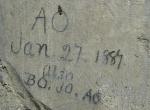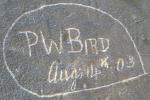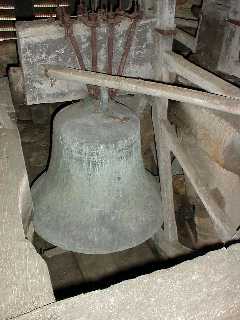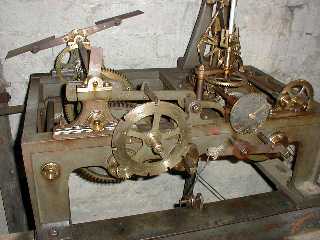
St Peter's church

 St Peter's church |
 |

|

|

|
|
Children of Reverend George Sandford Outram appear to have been frequent visitors to the church tower. In the clock room these inscriptions can be read.
Possible names are:- |
Augustus T. OUTRAM age 18 Beatrix E. OUTRAM age 16 Josephine S. OUTRAM age 14 Adelaide S. OUTRAM age 13 |
This graffiti on the spiral staircase was done on the 14th August 1903 by Philip W Bird aged 16, son of the church treasurer. See the 1901 census |
The three bells;
Treble - 1613, approx. 6cwts, inscribed "God save his church 1613":
Second - 1841, approx. 7.5cwts., inscribed "O LORD SAVE THY PEOPLE MDCCCXLI" :
Tenor - 1770, approx. 10cwts, inscribed "Robert Hand Churchwarden Tho.Hedderley founder 1770".
Thomas Hedderley, bell founder of Nottingham also worked at Wymeswold in 1742, Hucknall (Notts) 1749, Ashford in the Water (Derbys) Shelford (Notts) 1754 and East Norton 1779.
|
From "The History and Antiquities of the County of Leicester by John Nichols, 1795" 1st Inscribed "God safe his church 1613" 2nd Inscribed "God safe his church 1703" 3rd Inscribed "Jhesus be oure spede" We can only assume from this that John Nichols either used old information or took some time to compile his books as it appears the tenor was recast by Thomas Hedderley of Nottingham in 1770. The wooden frame is thought to date from the 17th century with evidence of an earlier frame. This equates with the comment in North re two bells and a sanctus bell being in the tower in the 6th year of Edward VI's reign, ie 1553. When the bells are rung together it is called 'firing the bells'. They were rung in times of disaster but were not rung at all for 5 years during the 2nd World War as arrangements were made to ring bells only if the enemy actually landed in England. The bells are now unringable but, were chimed for services within living memory.
|

|
The turrett clock

|
The clock in the tower was placed there by public subscription on the occasion of the coronation of Edward VII but delay in accumulating the £65 needed, meant it was finally installed in 1907. It was supplied and is marked 'G&F Cope (W. Cope) makers of Nottingham, 1907'. Inscribed on the count wheel are the names: Rev.F.T. Hetling M.A. Rector: D.S. Carlile & Wm. Mackley churchwardens: J.J. Bird treasurer. We know, from a number of sources, that this clock replaced an earlier clock (see 1900 Kelly's Directory of Leicestershire and Rutland) but unfortunately have no details about it. The clock strikes the hour on the tenor bell. It is still hand wound and due to the insertion of a new ceiling the weights are unable to travel the original distance and now it needs winding every five days. The single dial on the south face of the tower is of cast iron and painted blue with gold numerals it was last painted for the Queen's Silver Jubilee in 1977. |
William King memorial to his 1st wife in the chancel - The 4th Duke of Rutland died in 1787 but his Agent, William King, exerted a notable influence during the minority of John, 5th Duke of Rutland, until 1801 and actively encouraged efforts towards the realisation of the Grantham to Nottingham canal. This was fortunate for without his support it is doubtful if the canal would have been built at all.
The organ - was installed in 1870 by Foster & Andrews of Hull, at a cost of £120. Behind the organ is the vestry, a later Victorian addition. It was used as a Sunday school and there are still old pegs with names attached where the choir and clergy hung their clothes. There are several memorial tablets on the walls.
John de Knipton gave a bovate of the territory of Redmile to the altar of St. Mary which he had founded in Redmile church". possibly mid 1200's.
There is a blocked doorway on the North side but this could be a 'mock' doorway, built to allow 'the devil to leave' as, by tradition he was reputed to leave by a north door. The outside face of this contains a stone mantlepiece, possibly from the house mentioned in an inventory of 1352, of William de Ros who held a manor house with chapel - probably 'All Hallows' site.
On the window ledge of the south - east window can be seen signs of a carved 'Nine Man's Morris' game. This may be a relic from the days when the local boys were taught here - in 1626 the curate taught, in 1635 there was a master.
Reverend Thomas Daffy Vicar of Redmile 1666 - 1680 inventor of Daffy's 'elixir salutis,' A Saxon coffin lid, located near the pulpit, was found when the railway was constructed in the 1870's. The railway construction partially destroyed the 'All Hallows' site. Bones collected at the time were re-buried in the churchyard.
In 1827 the church was re-pewed with box pews, but these were removed in the 1880's
The chancel window was installed in 1859 look along the bottom for this information. See also the 1841 census
| Erected by the five children of Thomas Powys | Outram and Ann his wife to the Glory of God in | affectionate memory of their parents AD 1859 |

|
The Outram family burial plots are located in the churchyard opposite this window. Athough George Sandford left the parish in 1890 his body was laid to rest, when he died in 1897, alongside his father Thomas Powys Outram.
"This world it is a city full of crooked streets
James Handley died 11 day of March 1694.
This poem is on the reverse of his headstone find out more
Churchyard survey 2006 An index to churchyard Memorial Inscriptions
Death is a market place where all men meet.
If life were Marchandice that men could buy
Rich men would ever live and poor men die."